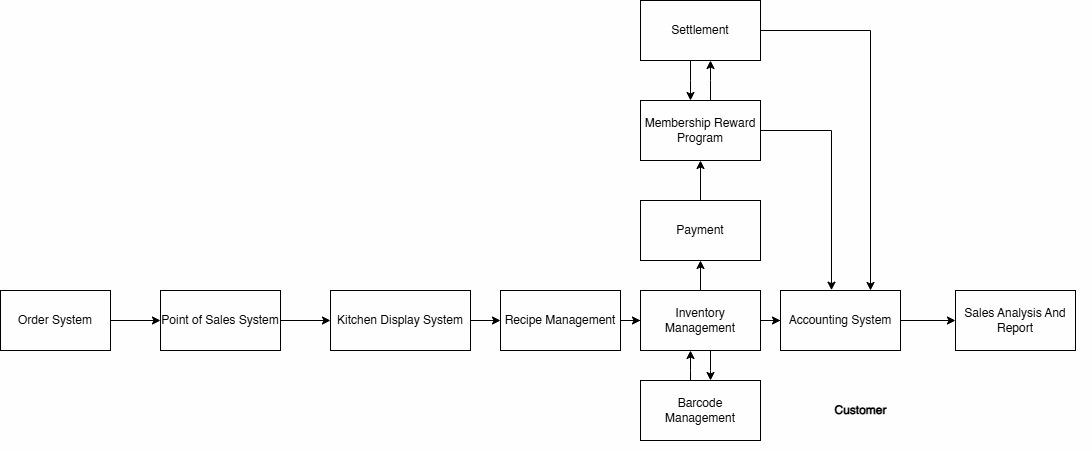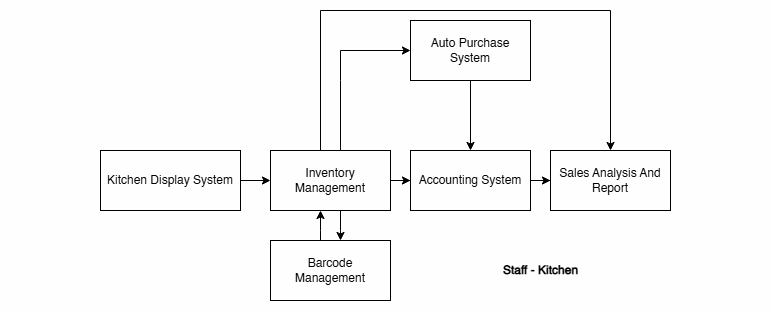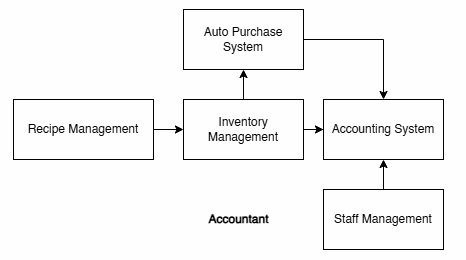𝒮𝐼𝒮𝒯𝐸𝑀 𝒫𝒪𝒮
Apakah SISTEM POS?
Faedah Menggunakan Sistem POS
Kecekapan
Mempercepatkan proses pembayaran dan mengurangkan ralat manusia.
Kawalan Inventori
Kemas kini masa nyata membantu menjejak tahap stok produk.
Data Insights
Menawarkan laporan jualan terperinci yang membantu dalam analisis perniagaan dan membuat keputusan.
Membolehkan transaksi pantas dan menyediakan program kesetiaan untuk pelanggan.
Pembayaran Bersepadu
Mempercepatkan proses pembayaran dan mengurangkan ralat manusia.
Mengapa Kita perlu menggunakan Sistem POS
- Akses Segera kepada Data Jualan : Menyediakan cerapan masa nyata tentang jualan, membantu pemilik PKS menjejaki prestasi, mengenal pasti arah aliran dan menyesuaikan strategi.
- Laporan Terperinci : Menjana laporan automatik (cth., untung-rugi, inventori, prestasi pekerja), menjimatkan masa dan menawarkan kejelasan, sesuai untuk PKS tanpa pasukan perakaunan yang berdedikasi.
- Customer Insights : Menjejaki gelagat pembelian, pilihan dan kekerapan lawatan untuk membantu menyesuaikan strategi pemasaran dengan keperluan pelanggan.
- Kecerdasan Perniagaan : Menganalisis aliran jualan, bermusim dan demografi pelanggan untuk memaklumkan keputusan perniagaan dan meningkatkan keuntungan.
Hubungan Mengenai Semua Sistem

Pelanggan
Apabila pelanggan memasuki restoran dan membuat pesanan, sistem menjana pesanan dan menghantarnya ke Sistem Paparan Dapur (KDS) . Selepas dapur menerima tempahan, sistem secara automatik menyemak sama ada bahan yang diperlukan ada dalam stok menggunakan Sistem Pengurusan Inventori . Jika inventori mencukupi, dapur meneruskan penyediaan makanan berdasarkan resipi standard dalam Sistem Pengurusan Resipi . Setelah hidangan siap, pesanan dihantar ke kaunter, dan kakitangan menghantar makanan ke meja pelanggan.
Selepas pelanggan selesai makan dan bersedia untuk membayar, sistem menyemak sama ada pelanggan adalah ahli restoran. Jika ya, sistem secara automatik menggunakan sebarang diskaun atau promosi , mengira jumlah akhir yang perlu dibayar. Selepas pembayaran, sistem POS menjana resit dan mencetaknya untuk pelanggan sebagai bukti pembayaran. Resit ini, bersama dengan butiran transaksi, disimpan secara automatik ke dalam Sistem Perakaunan untuk rekod kewangan. Akhir sekali, sistem perakaunan menjana **laporan kewangan** berdasarkan data transaksi yang dikumpul, membantu restoran dengan operasi harian dan analisis kewangan.
Proses ini mengautomasikan keseluruhan aliran kerja daripada penempatan pesanan kepada pembayaran, meningkatkan kecekapan restoran, mengoptimumkan pengalaman pelanggan dan memastikan ketepatan dan ketelusan dalam data kewangan.
Kakitangan - Depan rumah(FOH)
Apabila pelanggan membuat pesanan, kakitangan FOH menghantarnya ke dapur melalui sistem POS . Sistem menyemak inventori dan dapur akan menyediakan makanan. Setelah siap, FOH menghantar makanan.
Selepas makan, kakitangan FOH menyemak keahlian dan menggunakan diskaun dengan menggunakan sistem. Pelanggan membayar, dan POS menjana resit, yang disimpan dalam Sistem Perakaunan untuk rekod dan pelaporan.
Proses automatik ini meningkatkan kecekapan, pengalaman pelanggan dan ketepatan kewangan.
3.drawio.png)
3.drawio.png)
Kakitangan - Dapur
Apabila pelanggan membuat pesanan, kakitangan Front of House (FOH) menghantar pesanan ke dapur melalui sistem POS . Sistem menyemak inventori untuk memastikan bahan-bahan mencukupi dan menyediakan hidangan berdasarkan Sistem Pengurusan Resipi. Jika sistem mengesan stok tidak mencukupi, sistem akan membuat pesanan secara automatik dengan peruncit untuk menyimpan semula. Setelah hidangan siap, dapur menghantar pesanan semula kepada FOH, dan kakitangan menghantarnya ke meja pelanggan.
Selepas makan, apabila pelanggan bersedia untuk membayar, kakitangan FOH menyemak sama ada pelanggan adalah ahli dan menggunakan sebarang diskaun. Pelanggan membayar, dan sistem POS menjana resit, yang disimpan dalam Sistem Perakaunan untuk penyimpanan rekod dan pelaporan.
Proses automatik ini meningkatkan kecekapan dapur, menambah baik pengalaman pelanggan dan memastikan ketepatan kewangan.
Accountant
Sebagai akauntan, anda menyelia beberapa sistem utama untuk memastikan operasi lancar. Sistem Pengurusan Resipi membantu mengesan penggunaan bahan dan kos untuk setiap hidangan. Sistem Pengurusan Inventori memantau tahap stok, memastikan bahan-bahan tersedia untuk penyediaan makanan. Jika inventori adalah rendah, Sistem Pembelian Auto secara automatik menjana pesanan untuk menambah stok daripada pembekal.
Sistem Perakaunan merekodkan semua transaksi kewangan, termasuk jualan, perbelanjaan dan pembayaran, menjana laporan untuk analisis kewangan . Pengurusan Kakitangan menjejaki waktu pekerja, senarai gaji dan prestasi, menyepadukan dengan sistem perakaunan untuk pengiraan gaji yang tepat.
Pendekatan bersepadu ini membantu menyelaraskan operasi restoran, mengurus kos dan mengekalkan rekod kewangan yang tepat.


Pengurus
Sebagai pengurusan, anda bertanggungjawab untuk menyelaras dan mengawasi keseluruhan operasi restoran. Sistem Pengurusan Resipi membantu mengawal kos ramuan, mengoptimumkan resipi hidangan, dan memastikan konsistensi dalam kualiti makanan. Sistem Pengurusan Inventori menjejaki tahap stok, memastikan bekalan bahan mentah tepat pada masanya dan mengelakkan stok berlebihan atau kekurangan.
Sistem Perakaunan merekodkan semua transaksi kewangan dan menjana laporan kewangan harian dan bulanan untuk pemantauan kewangan dan kawalan belanjawan. Sistem Analisis Jualan menyediakan cerapan mendalam tentang data jualan, membantu anda memahami hidangan yang paling popular, tempoh masa yang paling menguntungkan dan menyokong pembuatan keputusan berdasarkan data.
Akhir sekali, Sistem Pelaporan menyatukan semua data utama, membantu pengurusan membuat keputusan strategik berdasarkan data dan memastikan ketelusan dan kecekapan operasi.
Bos & Pemilik
Sebagai Bos/Pemilik, anda bertanggungjawab untuk mengawasi keseluruhan operasi restoran. Sistem Pengurusan Resipi membantu anda mengawal kos makanan dengan mengoptimumkan resipi dan penggunaan bahan, memastikan konsistensi dan kualiti merentas hidangan. Sistem Pengurusan Inventori membolehkan anda memantau tahap stok dalam masa nyata, mencegah kekurangan atau inventori berlebihan dan memastikan penggunaan bekalan yang cekap.
Sistem Perakaunan menjejaki semua transaksi kewangan, menjana laporan terperinci dan membantu dengan pengurusan belanjawan dan aliran tunai, memberikan cerapan tentang kesihatan kewangan restoran anda. Sistem Analisis Jualan menawarkan data berharga tentang arah aliran jualan, membantu anda mengenal pasti hidangan berprestasi tinggi, waktu perniagaan puncak dan kawasan yang boleh dibuat penambahbaikan.
Sistem POS berasaskan Awan berintegrasi dengan semua sistem lain, memperkemas pemprosesan pesanan, kemas kini inventori dan pembayaran pelanggan. Dengan kefungsian berasaskan awan, anda boleh mengakses data masa nyata dari mana-mana sahaja, membolehkan anda membuat keputusan termaklum semasa dalam perjalanan.
Akhir sekali, Sistem Pelaporan menyatukan semua data perniagaan utama, memberikan anda laporan komprehensif yang membolehkan anda membuat keputusan strategik dan memastikan kejayaan perniagaan jangka panjang.











